Tính Chất (Properties)
Đường Cong-F đang Hoạt Động (Active F-Curve)
Tham Chiếu (Reference)
- Panel (Bảng):
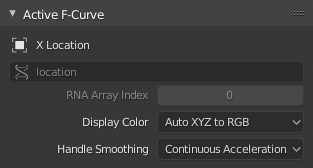
Bảng đường cong-F đang hoạt động.
Bảng này hiển thị các Tính Chất cho Đường Cong-F đang hoạt động.
- Tên Kênh (Channel Name)
ID Type + Channel name (X Location).
- Đường Dẫn Dữ Liệu (Data Path)
RNA Path to property.
- Chỉ Số Mảng RNA (RNA Array Index)
Index to the specific property affected by the F-Curve if applicable.
- Màu Hiển Thị (Display Color)
The method used to determine the color of the F-Curve shown in the Graph editor.
- Tự Động Cầu Vồng Hóa (Auto Rainbow):
Increment the hue of the F-Curve color based on the channel index.
- Tự Động XYZ Sang RGB (Auto XYZ to RGB):
For property sets like location XYZ, automatically set the set of colors to red, green, blue.
- Người Dùng Định Nghĩa (User Defined):
Define a custom color for the active F-Curve.
- Làm Mịn Tay Cầm (Handle Smoothing)
Selects the method used to compute automatic Bézier handles (Automatic, Auto Clamped, Vector).
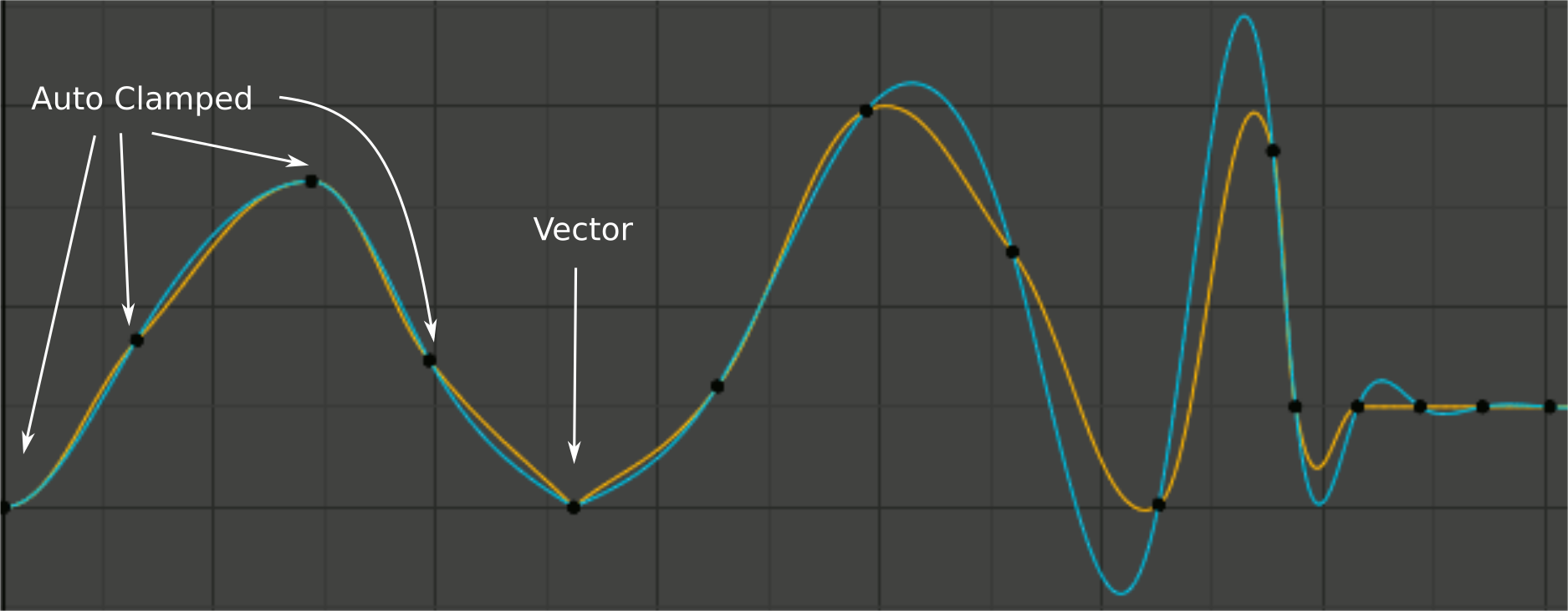
Xử lý so sánh chế độ làm mịn.
Yellow: None, Cyan: Continuous Acceleration. From left to right, four Auto Clamped keys, one Vector, and the rest are Automatic.
- Không (None):
Only directly adjacent key values are considered when computing the handles. Vector handles are pointed directly at the adjacent keyframes.
This older method is very simple and predictable, but it can only produce truly smooth curves in the most trivial cases. Note the kinks in the yellow curve around the keys located between the extremes, and near the Vector handles.
- Tăng Tốc Liên Tục (Continuous Acceleration):
A system of equations is solved in order to avoid or minimize jumps in acceleration at every keyframe. Vector handles are integrated into the curves as smooth transitions to imaginary straight lines beyond the keyframe.
Nó tạo ra các đường cong mượt mà hơn nhiều, song sự đòi hỏi cần thiết có nghĩa là bất kỳ thay đổi nào trong các giá trị của khóa có thể ảnh hưởng đến phép nội suy trên một đoạn đường cong đáng kể; mặc dù lượng thay đổi giảm dần theo cấp số nhân với khoảng cách. Quá trình lan truyền thay đổi này bị dừng lại bởi bất kỳ khóa nào có tay cầm "Phóng Thích/Thả/Tự Do/Miễn Phí", "Thẳng Hàng", hoặc "Véctơ", cũng như các phím cực trị có tay cầm "Tự Động Hạn Định".
The mode also tends to overshoot and oscillate more with fully Automatic handles in some cases (see the right end of the image above). So it is recommended to use Auto Clamped by default, and only switch to Automatic handles in places where this is desired behavior. That effect can also be reduced by adding in-between keys.
Mẹo
Xem xét các mặt tích cực và tiêu cực của mỗi chế độ, "Tăng Tốc Liên Tục" sẽ phù hợp hơn với hoạt họa ngắn, sử dụng một số lượng nhỏ các khóa nội suy với ít nhất công sức để trau truốt thủ công. Trong trường hợp hoạt họa đòi hỏi tính trau truốt cao với tỷ lệ khung khóa lớn, lợi ích của việc làm mịn có thể không còn giá trị hơn sự gián đoạn trong quy trình làm việc do sự lan truyền thay đổi xảy ra rộng lớn hơn.
Khung Khóa đang Hoạt Động (Active Keyframe)
Tham Chiếu (Reference)
- Panel (Bảng):
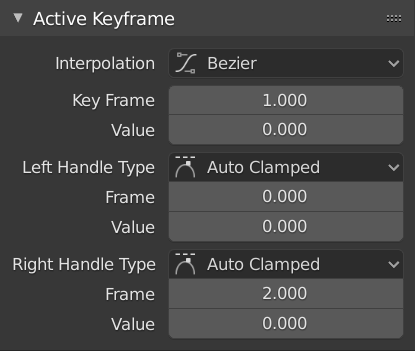
Bảng Khung Khóa đang hoạt động.
- Interpolation (Nội Suy)
Mode for the Interpolation between the current and next keyframe.
Interpolation (Nội Suy)
- Hằng Số/Đồng Đều/Bất Biến (Constant):

Hằng Số/Đồng Đều/Bất Biến.
There is no interpolation at all. The curve holds the value of its last keyframe, giving a discrete (stairway) "curve". Usually only used during the initial "blocking" stage in pose-to-pose animation workflows.
- Tuyến Tính (Linear):
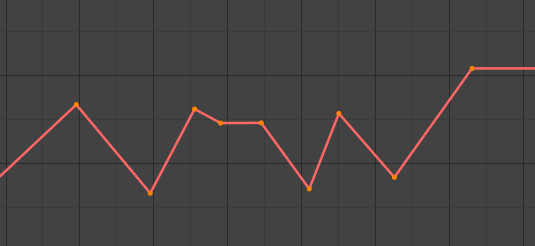
Tuyến Tính.
This simple interpolation creates a straight segment, giving a non-continuous line. It can be useful when using only two keyframes and the Extrapolation extend mode, to easily get an infinite straight line (i.e. a linear curve).
- Bézier (Đường Cong Bézier):

Bézier.
The more powerful and useful interpolation, and the default one. It gives nicely smoothed curves, i.e. smooth animations!
Ghi chú
Remember that some F-Curves can only take discrete values, in which case they are always shown as if constant interpolated, whatever option you chose.
Chậm Rãi [theo cường độ] (Easing [by strength])
Different methods of easing interpolations for F-Curve segment. The "Robert Penner easing equations" (basically, equations which define some preset ways that one keyframe transitions to another) which reduce the amount of manual work (inserting and tweaking keyframes) to achieve certain common effects. For example, snappy movements.
Tuyến Tính (Linear)
Sinusoidal
Bình Phương (Quadratic)
Lập Phương/Bậc Ba (Cubic)
Quartic
Quintic
Exponential
Circular
Xem thêm
For more info and a few live demos, see https://easings.net and http://robertpenner.com/easing/
Các Hiệu Ứng Năng Động (Dynamic Effects)
These additional easing types imitate (fake) physics-based effects like bouncing/springing effects. The corresponding settings can be found in the .
- Sau Lưng/Quay Trở Lại:
Cubic easing with overshoot and settle. Use this one when you want a bit of an overshoot coming into the next keyframe, or perhaps for some wind-up anticipation.
- Sau Lưng/Quay Trở Lại
The back property controls the size and direction (i.e. above/below the curve) of the overshoot.
- Bật Nẩy (Bounce):
Exponentially decaying parabolic bounce, like when objects collide. e.g. for Bouncing balls, etc.
- Elastic (Đàn Hồi):
Exponentially decaying sine wave, like an elastic band. This is like bending a stiff pole stuck to some surface, and watching it rebound and settle back to its original state.
- Biên Độ (Amplitude)
The amplitude property controls how strongly the oscillation diverges from the basic curve. At 0.0, there is no oscillation (i.e. it just snaps to the B-value like an extreme exponential transition), and at 1.0 a profile similar to the one shown in the icon occurs.
- Chu Kỳ (Period)
The period property controls the frequency with which oscillations occur. Higher values result in denser oscillations.
- Chậm Rãi (Easing)
The Easing Type controls which end of the segment between the two keyframes that the easing effects apply to. It has no effect if the Interpolation Mode is set to either Constant, Linear, or Bézier.
- Chậm Rãi Tự Động (Automatic Easing):
The most commonly expected of the below behaviors is used. For the transitional effects, this is basically ease in, while for the physics effects it is ease out.
- Chậm Rãi Vào (Ease In):
Effect builds up to the second keyframe.
- Chậm Rãi Ra (Ease Out):
Effect fades out from the first keyframe.
- Chậm Rãi Vào Ra (Ease In Out):
Effect occurs on both ends of the segment.
- Khung Khóa (Key Frame)
Set the frame for the active keyframe.
- Value (Giá Trị)
Set the value for the active keyframe.
- Kiểu Tay Cầm Trái / Phải (Left/Right Handle Type)
When using Bézier-interpolated curves it is possible to control the slope of the curve at the control points. This is done via the curve point handles; you can set the type of handle to use for the curve points by pressing V or choosing Key, Handle Type in the Graph editor menu. Each curve point can have a different handle type, even within the same curve.
There are three automatic modes, Automatic, Auto Clamped, and Vector, where Blender automatically determines the curve's slope at each control point. The neighboring control points have the most influence of the slope, and points further away have a smaller influence. This can be controlled per F-Curve with the Auto Handle Smoothing properties.
By using the other, non-automatic modes, you have full manual control over the slope.
- Tự Động (Automatic):
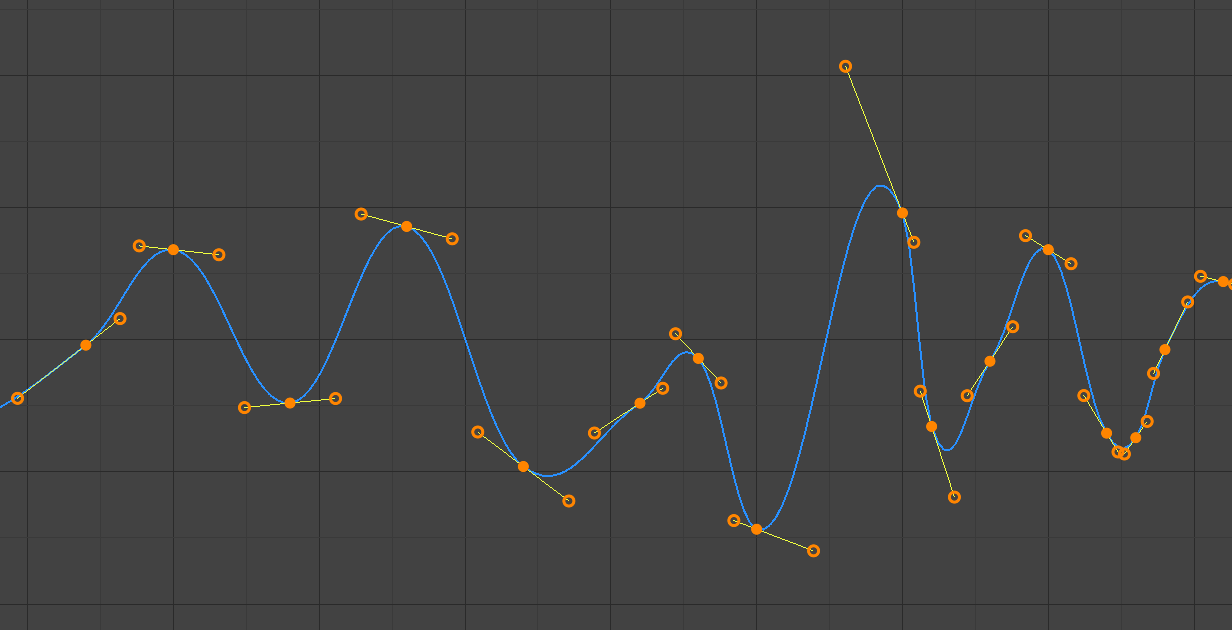
Các tay cầm tự động.
Handle positions are automatically chosen to produce smooth curves.
- Tự Động Hạn Định (Auto Clamped):
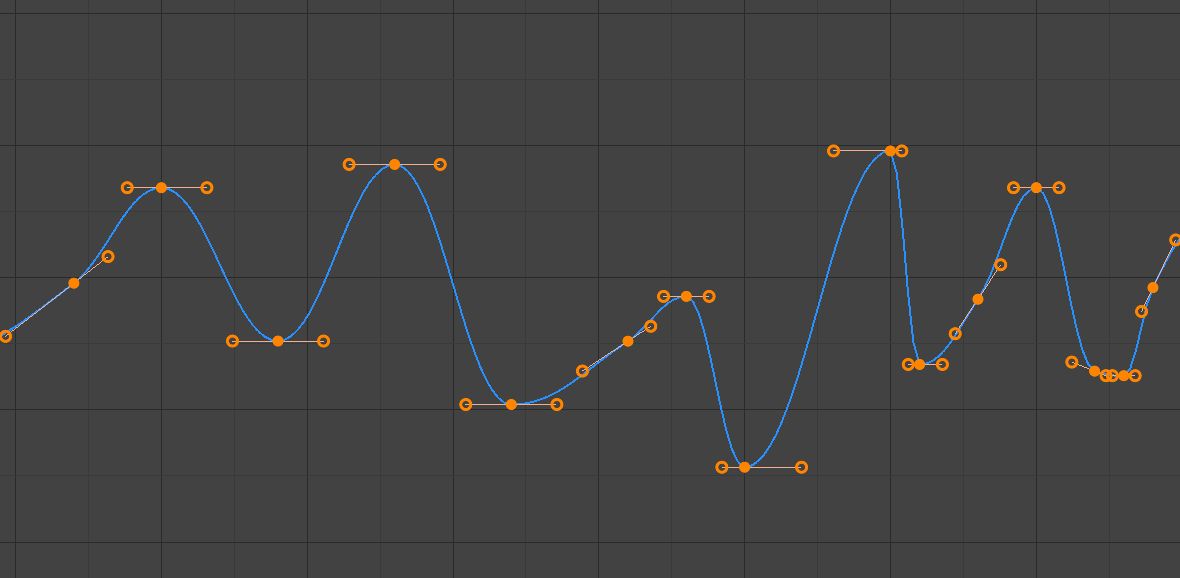
Các tay cầm hạn định.
Tay cầm tự động bị hạn định hòng để ngăn chặn những trường hợp không kiềm chế xảy ra và thay đổi chiều hướng của đường cong giữa các khung khóa (hình chữ-S).
- Véctơ (Vector):
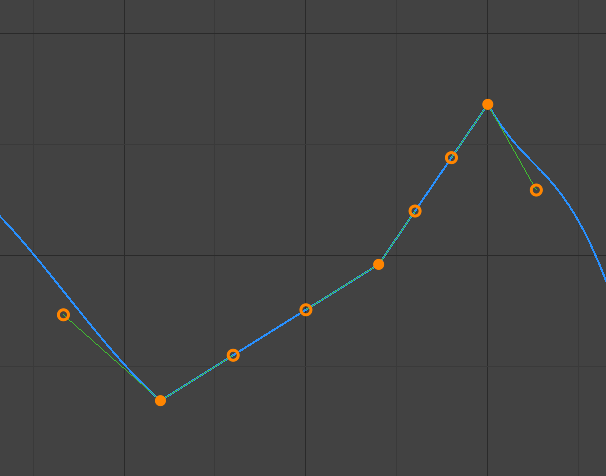
Các tay cầm Véctơ.
Creates automatic linear interpolation between keyframes. The segments remain linear when keyframe centers are moved. However, when the handles are moved, the handle type switches to Free.
- Thẳng Hàng (Aligned):
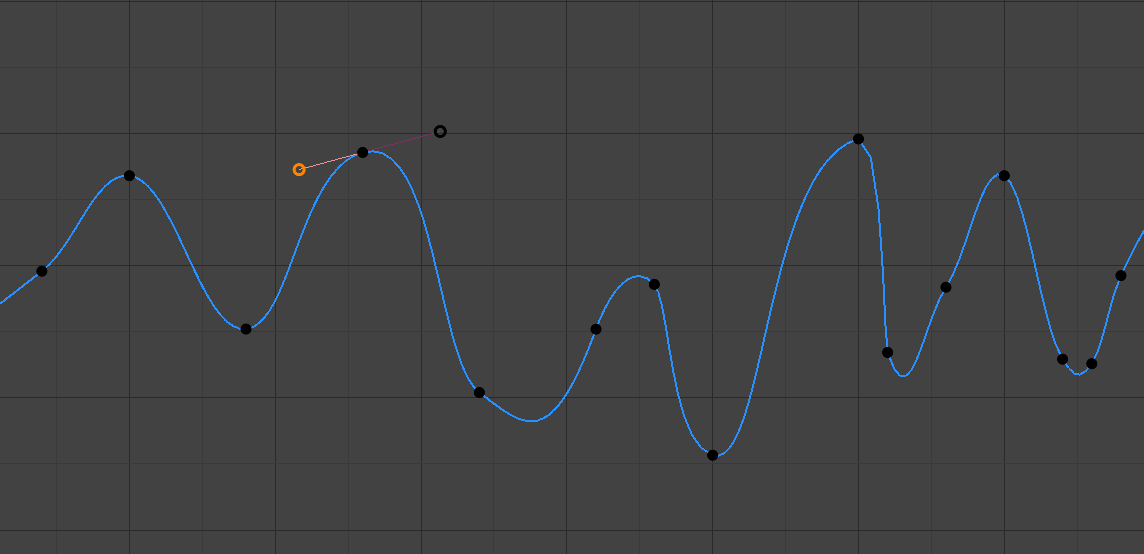
Các tay cầm thẳng hàng .
Hai tay cầm của điểm đường cong được khóa với nhau để luôn hướng về các hướng hoàn toàn ngược nhau. Điều này dẫn đến một đường cong luôn trơn tru tại điểm điều khiển.
- Tự Do (Free):
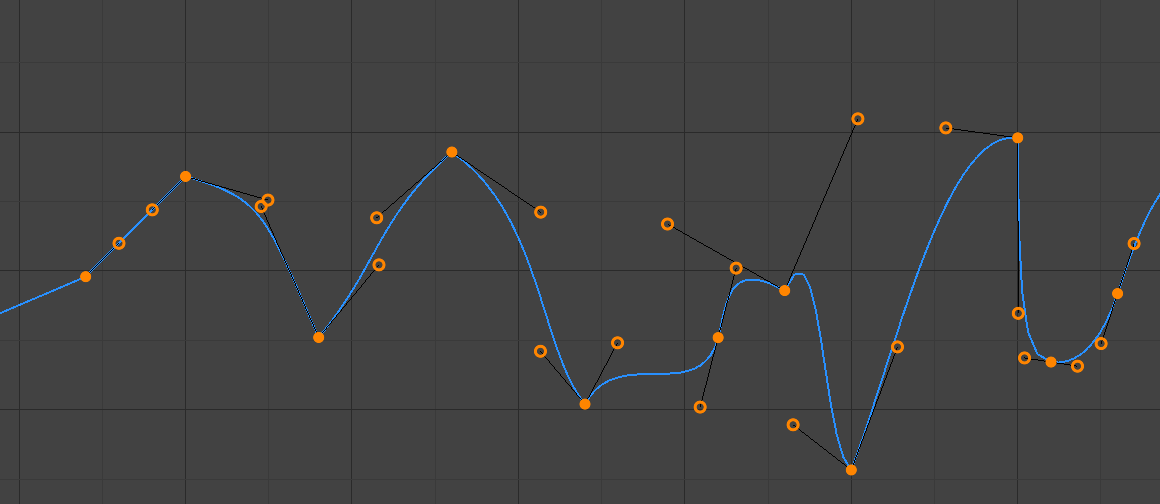
Các tay cầm tự do.
Các tay cầm có thể được di chuyển hoàn toàn độc lập, và do đó có thể dẫn đến sự thay đổi chiều hướng đột ngột.
- Khung Hình, Giá Trị (Frame, Value)
Set the frame and value for the left/right interpolation handle for the active keyframe.